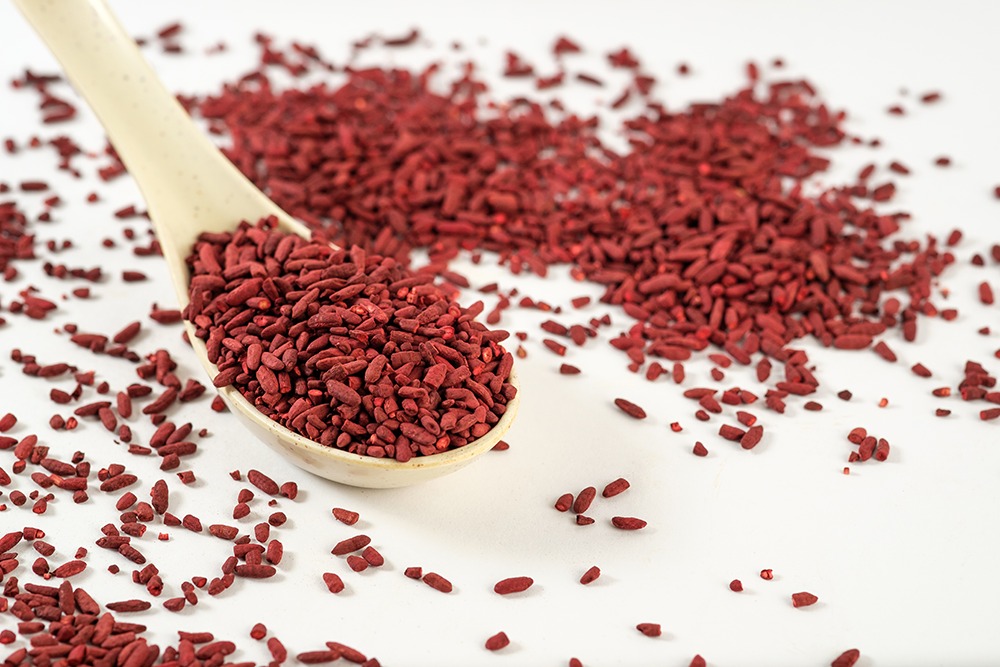Common myths about cholesterol, foods and fats
 Guest post provided by Rebecca S. Reeves, DrPH, RD, FADA
Guest post provided by Rebecca S. Reeves, DrPH, RD, FADA
2013 is shaping up to be a year of prevention, which should have you thinking about how well you are treating your own heart. If you are trying to maintain healthy cholesterol levels, or your doctor has said that you need to lower your cholesterol, you are probably trying to keep a close eye on your diet.
This does not mean that you must avoid all your favorite foods. What it might take is substituting different ingredients in a recipe or stir-frying a food rather than deep fat frying it.
Learning the difference in the types of fat that we eat and where these fats are found in our food is also important to controlling the cholesterol levels in our blood. Taking precautions today could prevent a heart condition tomorrow.
Here are some of the most common myths and facts that you should know.
Continue reading
Phytosterols, Red Yeast Rice, and Cholesterol

Phytosterols (plant sterols) are similar in structure to cholesterol. Consuming phytosterols as part of your diet can decrease total cholesterol because molecularly they are very similar to cholesterol. As you digest phytosterols they can prevent cholesterol from being absorbed into the bloodstream and therefore the cholesterol that is not absorbed is removed from the system as waste.
Red yeast rice is a fermented product where red yeast has grown on rice. It acts as a natural statin drug in that it forms monacolins (HMG-CoA reductase inhibitors) that lower cholesterol levels. Red yeast rice contains isoflavones, sterols, and monounsaturated fats that also promote lower cholesterol levels.
A study published April 2012 in the Journal of Dietary Supplements studied 18 individuals with high cholesterol. Daily for six weeks the 18 participants received a combination of phytosterols and red yeast rice.
Study results found the supplement combination decreased total cholesterol 19% and LDL Cholesterol 33%. No changes were seen in triglycerides, HDL cholesterol, blood pressure, BMI, or liver function.
For comparison, a 1999 study published in the Journal of the American Medical Association found statins to reduce LDL Cholesterol 28%.
Granted, this wasn’t a large study, but it does show there is likely a way to achieve the results of statins (or even better results) without needing the medication and the potential side effects.
Explore all your options with your doctor.
Keep in mind that even though red yeast rice is naturally occurring, it can deplete coenzyme Q10 levels just like statin drugs. Coenyzme Q10 plays a key role within every cell for energy production. Some coenzyme Q10 deficiency symptoms include aches/pains, fatigue, sore muscles, weakness, and shortness of breath. Be sure to supplement coenzyme Q10 if taking red yeast rice or statin medications.
Access the free e-course How to Lower Cholesterol in 8 Simple Steps at http://lowercholesterolwithlisa.com.
 |
Heart Health Made Easy: Master the Basics to Lower Blood Pressure and Cholesterol for a Longer, Healthier Life
|
How do you increase your intake of plant sterols?
Plant sterols and stanols are not found at high levels in foods. For this reason food manufacturers have found ways to fortify foods with plant sterols and stanols.
Some foods that are fortified with plant sterols and stanols include spreads, juices, milk, breads, salad dressings, and yogurt.
Lower LDL Cholesterol with Pistachios
I think it’s fairly well known that walnuts provide some heart health benefits, but were you aware pistachio’s can be a good choice as well?
Pistachios are a good source of many nutrients, vitamins, and minerals.
A 1 ounce (28 grams) serving of pistachios provides:
170 calories
6 grams protein
2.9 grams fiber
73.4 mg omega 3 fatty acids
59.9 mg phytosterols
Pistachios are also a good source of copper, manganese, vitamin B6, thiamin, magnesium, and phosphorous. They also provide lutein and zeaxanthin, two carotenoids associated with a lower risk of age-related macular degeneration.
But, how do pistachios positively impact cholesterol and heart health?
3 Foods to Lower Cholesterol
Here are three foods you can incorporate into your diet to promote a lower cholesterol.
1. Navy Beans
Navy beans are a great source of dietary fiber. Dietary fiber promotes a lower cholesterol level, specifically soluble fiber which can lower LDL cholesterol 1% for every 1-2 grams of soluble fiber consumed daily. Aim for 25-35 grams of dietary fiber daily. Cooked navy beans provide 6 grams of fiber per ½ cup.
Some additional sources of dietary fiber include broccoli, oatmeal, blueberries, and brown rice.
Lower LDL Cholesterol Diet – Step 4
Let’s do a quick review. Step 1 of a diet to lower LDL cholesterol is to reduce saturated fat intake, step 2 increase soluble fiber, and step 3 increase plant sterol intake. The fourth step does not involve diet, but is an important part of maintaining a low LDL cholesterol level.
Here is the fourth of four options for lowering LDL cholesterol:
Physical Activity
Inactivity can cause higher cholesterol levels. Increase physical activity to increase HDL, lower LDL, and lower triglyceride levels. Check with your physician before starting an exercise program if you’re not currently active.
Lower LDL Cholesterol Diet – Step 1
Lower LDL Cholesterol Diet – Step 2
Lower LDL Cholesterol Diet – Step 3
Receive a step by step plan to promote heart health with a Mini Diet Makeover. As a special New Year’s bonus you’ll receive a complimentary copy of the Calorie Counter for Dummies. Learn more here – https://www.lisanelsonrd.com/minidietmakeover.html
All the best,
Lisa Nelson RD
How to Lower Cholesterol in 8 Simple Steps



